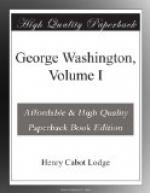He had just passed his sixteenth birthday. He was tall and muscular, approaching the stature of more than six feet which he afterwards attained. He was not yet filled out to manly proportions, but was rather spare, after the fashion of youth. He had a well-shaped, active figure, symmetrical except for the unusual length of the arms, indicating uncommon strength. His light brown hair was drawn back from a broad forehead, and grayish-blue eyes looked happily, and perhaps a trifle soberly, on the pleasant Virginia world about him. The face was open and manly, with a square, massive jaw, and a general expression of calmness and strength. “Fair and florid,” big and strong, he was, take him for all in all, as fine a specimen of his race as could be found in the English colonies.
Let us look a little closer through the keen eyes of one who studied many faces to good purpose. The great painter of portraits, Gilbert Stuart, tells us of Washington that he never saw in any man such large eye-sockets, or such a breadth of nose and forehead between the eyes, and that he read there the evidences of the strongest passions possible to human nature. John Bernard the actor, a good observer, too, saw in Washington’s face, in 1797, the signs of an habitual conflict and mastery of passions, witnessed by the compressed mouth and deeply indented brow. The problem had been solved then; but in 1748, passion and will alike slumbered, and no man could tell which would prevail, or whether they would work together to great purpose or go jarring on to nothingness. He rises up to us out of the past in that early springtime a fine, handsome, athletic boy, beloved by those about him, who found him a charming companion and did not guess that he might be a terribly dangerous foe. He rises up instinct with life and strength, a being capable, as we know, of great things whether for good or evil, with hot blood pulsing in his veins and beating in his heart, with violent passions and relentless will still undeveloped; and no one in all that jolly, generous Virginian society even dimly dreamed what that development would be, or what it would mean to the world.
It was in March, 1748, that George Fairfax and Washington set forth on their adventures, and passing through Ashby’s Gap in the Blue Ridge, entered the valley of Virginia. Thence they worked their way up the valley of the Shenandoah, surveying as they went, returned and swam the swollen Potomac, surveyed the lands about its south branch and in the mountainous region of Frederick County, and finally reached Mount Vernon again on April 12. It was a rough experience for a beginner, but a wholesome one, and furnished the usual vicissitudes of frontier life. They were wet, cold, and hungry, or warm, dry, and well fed, by turns. They slept in a tent, or the huts of the scattered settlers, and oftener still beneath the stars. They met a war party of Indians, and having plied them with liquor, watched one of their




